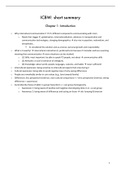Samenvatting
Short summary: intercultural communication in the business world
This is a short summary of the lectures 'intercultural communication in the business world' by Dieter Vermandere. Go through the powerpoints of the professor. After that, this short summary will be sufficient to study this course. Tip: go through the book to read some cases, as he will ask 1 on the...
[Meer zien]



